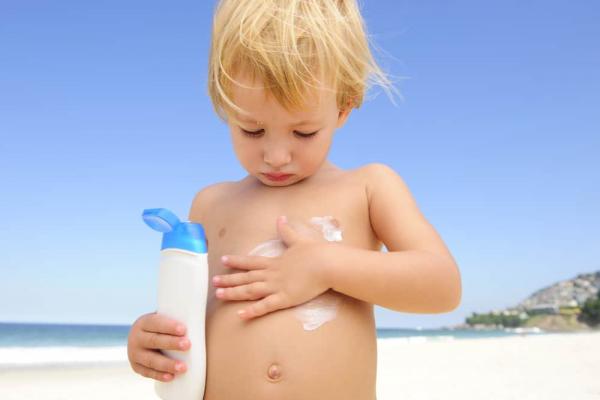
Most people understand that frequent tanning can be harmful, but does that mean your child should always be covered up? How much is too much sun? This article covers how to protect your child from harmful rays and what to watch for.
How much sun is OK?
"Just a few serious sunburns can increase your child's risk of skin cancer later in life"� according to the Center for Disease Control. So how much sun exposure is OK for my child? Is it OK to be in the sun as long as he doesn't burn? How can I protect him from the sun and help prevent cancers later in life?
Children spend large quantities of time outside during the summer months so sun exposure can be a concern for parents. According to the CDC, skin can be damaged after only 15 minutes of sun exposure. This means that even tanning damages the skin and increases the chance of skin cancer later in life. Therefore, limiting your child's exposure to sunlight is the best preventative measure that you can take.
Your child needs sun protection whenever out of doors. Even on a cool or cloudy day your child can be exposed to UV rays. Wearing a cap or hat that covers the face, ears and neck is ideal. Wearing clothing that covers exposed areas is another effective method of protecting the skin from the sun. Wear sunglasses that block out UVA and UVB rays (as close to 100 percent as possible) to help prevent cataracts later in life. Children under the age of 6 months should be kept out of direct sun.
Unlocking the secrets of SPF
When covering up is not possible, the use of sunscreen is recommended. It should be reapplied every two hours. The SPF refers to the sunscreen's ability to block out UV rays. A broad spectrum sunscreen with an SPF of at least 15 is recommended and means that you can be in the sun 15 times longer, before burning, than without sunscreen. However, protection does not increase proportionately to the SPF number. For example, an SPF of 15 blocks 93 percent of UV rays and an SPF of 34 absorbs 97 percent (American Melanoma Foundation, 2006).
Is it cancer?
While skin cancer is rare in children, parents should check their children regularly and keep track of moles and other marks on the skin. Melanoma accounts for 50 percent of all cancer and shows as moles that are large in diameter, asymmetric, have irregular borders or have irregular color. They can also be itching masses under the skin or moles or masses that bleed. Basal cell accounts for most of skin cancers. It usually grows in the top layer of skin. Basal cell is slow growing, is very treatable, and appears as a small and shiny bump on the skin. Squamous cell is also very treatable and appears as nodules or red, scaly patches. It is usually found on the face, mouth, and lips but can spread to other parts of the body (Children's Hospital, 2011).
As a parent I must keep in mind that the sun's rays are strongest at midday which is from 10 a.m. to 4 p.m. This time puts my child most at risk for sunburn. Tanning beds will damage the skin. Tanning beds can have over 10 times the intensity of the sun's rays. While there has been some discussion over the effect that sunscreen has on Vitamin D production, The British Journal of Dermatology says that regularly using sunscreen does not lead to Vitamin D deficiency.

